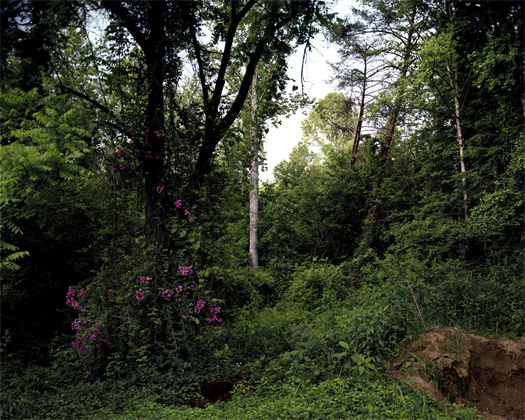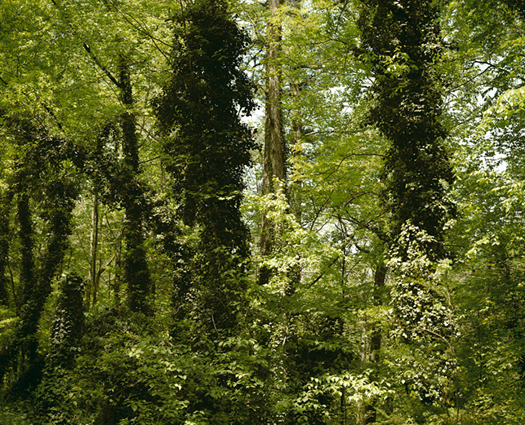A couple months ago, The Dirt highlighted an article from the Times about Alabama’s “War on Cogongrass”, in which Alabama’s forestry commission and a hired company of landscape managers, Mobile’s Larson & McGowin, deploy a series of escalating military metaphors (“killer”, “the Perfect Weed”, “war project”, “parallel attacks”, “eradicate”) against that rather aggressive species.

Alabama’s approach is perhaps a bit extreme in metaphor, but it is representative of the typical way in which invasive species are approached: as unwelcome interlopers disturbing peaceful ecosystems, evidence of the folly of simplistic and domineering early twentieth-century attitudes towards the human re-deployment of flora. But that attitude, too, may itself be simplistic. A recent article at Slate, Are invasive species really that bad for the environment?, summarizes scientific push-back against the making of binary distinctions between ‘native’ and ‘invasive’ plants:
…A growing contingent of scientists is advocating a more neutral attitude. Certainly, they say, non-native plants and critters can be terribly destructive—the tree-killing gypsy moth comes to mind. Yet natives such as the Southern Pine Beetle can cause similar harm. The effects of exotics on biodiversity are mixed. Their entry into a region may reduce indigenous populations, but they’re not likely to cause any extinctions (at least on continents and in oceans—lakes and islands are more vulnerable). Since the arrival of Europeans in the New World, hundreds of imports have flourished in their new environments. Common wildflowers such as Queen Anne’s lace and certain kinds of daisies are “naturalized” aliens. The storied apple tree originally hailed from Asia…
There’s an argument that even the dichotomy between “native” and “non-native” is ultimately meaningless. Species have always migrated; to identify one as native is to draw an arbitrary line in time. Davis favors a continuum, using labels such as “long-term resident” and “recently arrived”—the idea being that these terms are both more accurate and less loaded.
The debate is ultimately rooted in deeper and more fundamental arguments about the relationship between human culture, natural culture, and wilderness. As the idea of “nature” as something distinct from ourselves is in and of itself necessarily a social construct (there can be no idea of nature without a society to formulate it), so too the notions of the native plant (good) and the invasive plant (bad) are social constructs, though saying that something is a social construct is often misunderstood as an attack on the independent existence of the thing-in-itself, when it is more properly a way of re-examining our (human) relationship to a thing we misunderstand as existing wholly independently of ourselves.

One obvious implication of a more nuanced understanding of our relationship to nativeness and invasiveness is that, as Edible Geography notes, we can begin to think of species range and distribution as things to be cultivated:
It’s a radical idea: the scientists at Chicago Botanical Garden have determined that preserving the prairie ecology includes working out how to relocate it somewhere else altogether. Pati Vitt, a Conservation Scientist at the garden and one of the paper’s co-authers, told the Times reporter that, “I won’t be around in 100 years, but if the research isn’t there, we won’t know how to do it on that scale. That’s why the seed bank is so important.”
As Nijhuis points out, the implications of assisted migration directly contravene “the traditional conservation notion – call it an illusion, if you like – of a place to get back to.”… Their co-authored paper, “Assisted migration of plants: Changes in latitudes, changes in attitudes,” calls for globally agreed seed-banking and future-habitat-matching protocols. With a vision that rivals the space mirrors and artificial clouds of geo-engineering for sheer speculative wonder, Dr. Havens, Dr. Vitt, and their colleagues propose that plant conservationists around the world should be working as all-inclusive real estate agents, hunting down the next home for their clients before helping them pack up and move in.
I’m reminded of a studio project I once did (the particulars of which are not really worth sharing), in which one of the tangential approaches I developed involved using the Forest Service’s fantastic (in content, though not presentation) Climate Change Tree Atlas — it’s a literal atlas of the future (see, for instance, Kentucky Coffeetree evacuate Kentucy in favor of upstate New York and Minnesota, or Longleaf Pine slipping into the forests of Tennessee and New Jersey) — to anticipate what tree species might want to march through Virginia’s Prince William Forest Park in the coming century, and then proposed seeding those species along existing lines of disturbance (transmission lines, etc.) in the park. Which is not nearly so grand as Havens and Vitt’s call for a worldwide redistribution of species, but it does suggest that thinking of species range as something to cultivate (or hack!) opens up a fascinating territory for the landscape architect.


not sure that la’s work is here, but maybe, especially in the zones where species migration crosses through heavily human environments. E.O Wilson has a lot to say about the subject in “the diversity of life” which i’ve been plowing through recently. He notes that most species don’t migrate fast enough to keep up with the pace of change we’re seeing (and this was back in 1992) but that initial attempts to transplant certain species (he was working with butterflies) were effective, suggesting that human intervention can be effective. Of course, then you’d have to deal with NON-NATIVE BUTTERFLIES!
A friend of mine graduated with a Phd in Religion and Nature. He always used the term, non-human nature.
Additionally, many non-Western cultures make the clear point that humans are nature.
Also could LAs perhaps created the geography of natural selection to direct speciation?
faslanyc:
not sure that la’s work is here, but maybe
Certainly hacking species range is not going to become the new arrangement of subdivision plots or anything, and the migration of tree species is probably a bigger concern for other sets of land-related professions (foresters, for instance), but it seems to me like a valid concern for some landscape architects in at least some cases: the landscape architect from the Park Service who we worked with in the studio I mentioned, or one dealing with the question of what kind of forest might be appropriate to establish on a heavily disturbed urban site, for instance.
Agreed. at the very least, it’s another variable la’s should be cognizant of when designing the landscape and its systems, etc.
[…] that we ought to begin to value these plants (many of whom are often lumped together under the derogatory rubric of “invasives”) and the communities that they form, because they provide ecological services at a uniquely low […]
[…] of trees as performative machines, subject developed later by mammoth. As refered by Holmes in a previous post, he catched up our attention on some kind of vegetal infrastructure which appears in all cities: […]